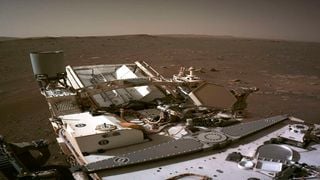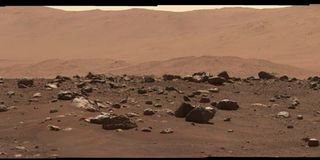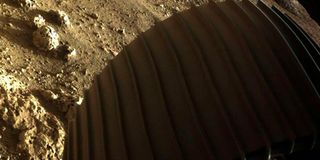
This NASA photo released on February 24, 2021 shows images from NASA’s Mars 2020 Perseverance rover of its new home in Jezero Crater on February 21, 2021, after touching down on the Red Planet on February 18, 2021.
| NASA | JPL-CALTECH | AFPNews
Premium
In search of life on the ‘Red Planet’
Rocks. Hills. Dust. More rocks. Deep escarpments. Zero vegetation. It is not a desert, though.
Sounds familiar? That is how the surface of Mars looks like in images sent back to Earth by Perseverance, the latest rover from America’s National Aeronautics and Space Administration (Nasa) to land on the faraway planet.
That planet we see as a bright heavenly object when it is closest to the Earth, and which geography students are taught to call the “Red Planet”, is now being revealed in ways never seen before through high-definition photography, leaving observers awe-struck by the fact that the planet’s surface, albeit dry and lifeless, looks a lot like ours.
In fact, if someone were to photograph a place like the hilly side of Voi and strip it of its vegetation, they can get away with describing it as the surface of Mars. The two planets might look similar but differences abound.

A photo taken by Perseverance of its new home in Jezero Crater on February 21 after touching down on the Red Planet on February 18, 2021.
With its low pull of gravity, in Mars there is a mountain as high as 25 kilometres, while on Earth there is no mountain taller than nine kilometres due to a stronger gravitational pull.
Carbon dioxide
Also, the air on Mars largely consists of carbon dioxide. The planet also takes 687 days to go round the sun, compared to the Earth’s 365. Getting to know how the planet looks and feels like has been many a scientist’s obsession for years, and they have used a number of approaches to understand how the planet, which is 55 million kilometres from Earth when closest to us, looks like.
Nasa leads the pack in the number of machines sent to Mars to explore its surface. Perseverance, which was sent to Mars on July 30, 2020, arrived there on February 18, drawing celebrations from the scientific community.
The machine with its own Facebook and Twitter accounts keeps wowing humanity with the images it has been sending. One of its most recent tweets says: “I’m part of a proud lineage of robotic explorers, carrying the torch forward on Mars.”
Weighing 1,025 kilogrammes (15 kilos heavier than a Toyota Vitz) and powered by a substance that is decaying radioactively to produce energy, the rover moves on six wheels and has a total of 23 cameras, some that take images that the rover uses to make decisions on how to move.
Before Perseverance, there was Curiosity, launched on November 26, 2011 to arrive on Mars on August 6, 2012. Like Perseverance, Curiosity also has a verified Twitter account. When Perseverance landed there, the rover tweeted a congratulatory message.

Panoramic photos released by Nasa on March 3, stitched together from 79 individual images, with a Mastcam-Z right-eye 110-mm zoom mosaic created from the camera’s first high-resolution panorama imaging sequence.
“So proud of you (Perseverance) and the work you will do paving the way for future astronauts, and searching Mars for signs of ancient life,” said Curiosity, which is still active and traversing the Mars surface. Before Curiosity there was Opportunity which landed in Mars in January 2004 and lost contact in 2018 when it was buried by a sandstorm.
Signs of life
There have also been the Sojourner, Spirit and Mars 3 rovers that recorded varying levels of success. As indicated in Curiosity’s tweet, the latest rover is out to explore signs of life on Mars.
One of the tools it is using for that purpose is a camera called Mastcam-Z, which Nasa describes as “an advanced camera system with panoramic and stereoscopic imaging capability with the ability to zoom”. Another specification says: “The left and right cameras are next to each other and point in the same direction, providing a stereo view similar to what human eyes would see.”
In a batch of photos Nasa released days ago, images captured by Mastacam-Z are among the most breath-taking. They include an area that is eerily similar to a hilly place on Earth. It also captured a sandy area of Mars that was so unique it was voted the photo of the week from the second week of Perseverance in Mars.
The camera also zoomed in on a mountainous feature that scientists studying the planet will be observing to see whether there are any signs of life.
As Perseverance sends more and more photos back to Earth, humanity is sure to keep marvelling about the closest planet to us that often appears the likeliest to support life.





